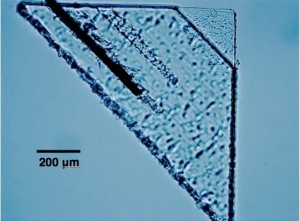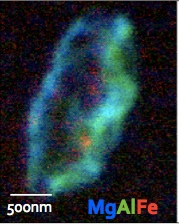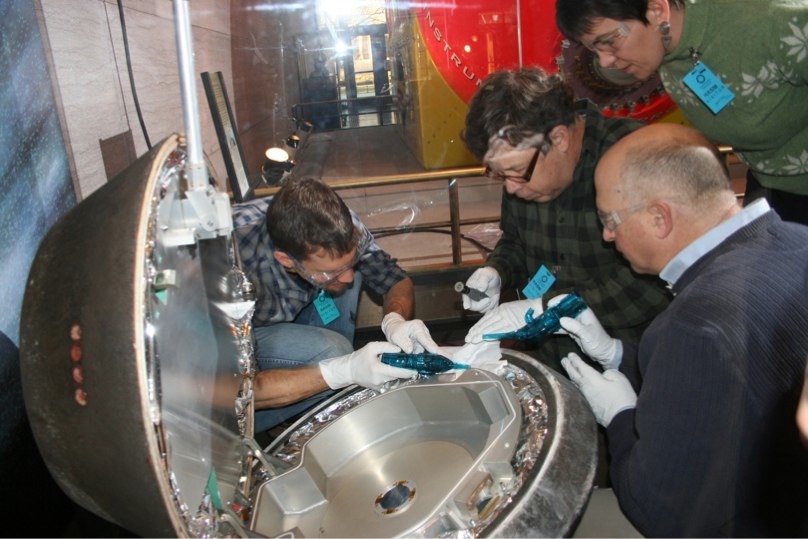New studies of space dust captured by NASA’s Stardust Interstellar Dust Collector have shown that interstellar particles may be much more complex in structure and composition than previously thought. The tiny particles could give scientists chemical clues about the origins of our solar system.

Researchers used a variety of techniques at various national user facilities to complete the analysis of the space dust particles, including the ALS. The x-ray capabilities at the ALS allowed them to study the particles in a non-destructive manner, preserving the structural and chemical properties of the few precious space dust particles. Researchers were able to distinguish seven possible interstellar particles from more than 50 spacecraft debris particles due to their elemental composition, trajectory, and flux. The presence of crystalline grains and multiple iron-bearing phases, including sulfide, in some particles indicated that individual interstellar particles diverged from any one representative model. The research team consists of 66 scientists from seven different countries along with 30,000 citizen scientists, self-named “dusters” using the online Stardust@home project, who have been examining millions of microscopic images of the Stardust Interstellar Dust Collector.

NASA’s Stardust spacecraft collected a stream of dust on its way to a comet between 2000 and 2002 and returned the particles to Earth in 2006 for laboratory analysis. The microscopic particles collected en route to the comet were captured by the spacecraft’s specialized sample-collection trays. Much of the analysis relied on novel methods and techniques developed specifically for handling and analyzing the fine grains of dust, which are more than a thousand times smaller than a grain of sand.
The analysis tapped a variety of microscopy techniques at the ALS, taking advantage of the bright synchrotron light source that enabled light to be focused down to the small size of the space particles, while also providing unprecedented chemical identification. Researchers used the scanning transmission x-ray and Fourier transform infrared microscopes. The x-ray microscope ruled out many of interstellar dust candidates because they contained aluminum metal, which is not found naturally and indicated that the material was merely knocked of the outside of the spacecraft by meteoroid impacts. The infrared spectroscopy was used to search for any possible organic materials that may have been captured with the interstellar dust.

The researchers found that the two larger dust particles captured in aerogel were very low density, consistent with a fluffy structure similar to that of a snowflake. Some models of interstellar dust particles had suggested single, dense particles, so the lighter structure was unexpected. They also contain crystalline material called olivine, a mineral made of magnesium, iron, and silicon, which suggest the particles came from disks or outflows from other stars and were modified in the interstellar medium. Three of the particles found in the aluminum foil were also complex, and contain sulfur compounds, which some astronomers believe should not occur in interstellar dust particles. Study of further foil-embedded particles could help explain the possible discrepancy.
Before this research project, understanding of space dust was derived primarily from astronomical observations of the interstellar medium and from in situ measurements by the dust analyzers on spacecraft. Direct, laboratory-based measurement of returned particles offers an independent test of the assumptions on which the interpretation of spectroscopy and in situ dust measurements rest.
The next step in dust analysis involves measurement of three stable isotopes of oxygen. Isotope analysis could help confirm that the dust originated outside the solar system, but it’s a process that would destroy the precious samples. For now, researchers are honing their isotope analysis techniques on artificial dust particles called analogs.

Contact: Andrew Westphal
Research conducted by: A.J. Westphal, et al. (http://www.sciencemag.org/content/345/6198/786.abstract#aff-1).
Research funding: NASA, the Klaus Tschira Foundation, the Tawani Foundation, the German Science Foundation, and the Funds for Scientific Research, Flanders, Belgium. In addition to ALS, the research made use of the National Center for Electron Microscopy at Berkeley Lab, the National Synchrotron Light Source at Brookhaven National Laboratory and the Advanced Photon Source at Argonne National Laboratory. Operation of the ALS is supported by the U.S. Department of Energy, Office of Basic Energy Sciences.
Publication about this research: A. J. Westphal, et al. “Evidence for interstellar origin of seven dust particles collected by the Stardust spacecraft,” Science 345, 786 (2014). doi: 10.1126/science.1252496
ALS SCIENCE HIGHLIGHT #299